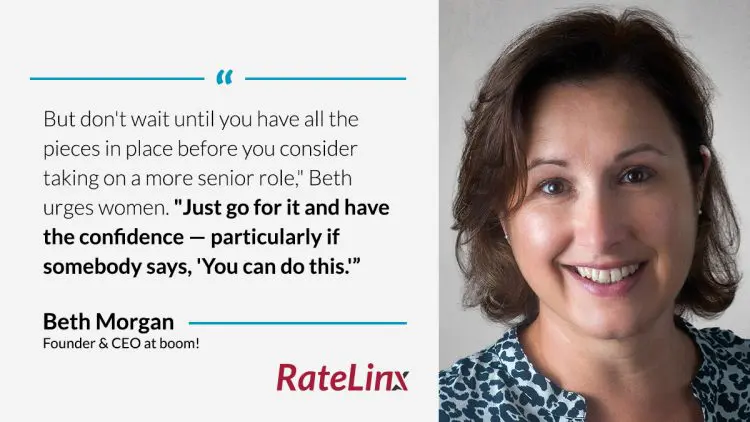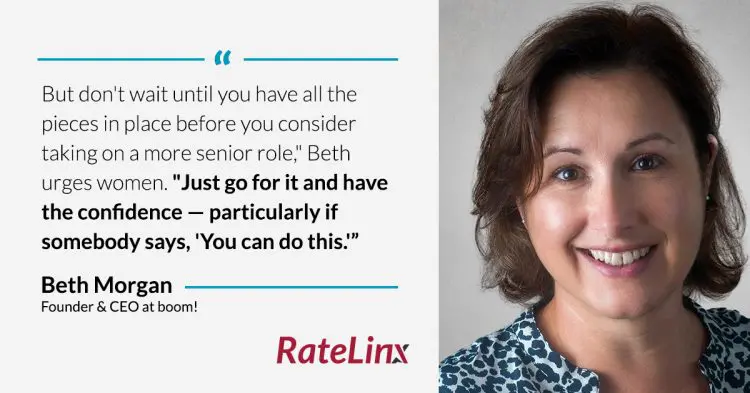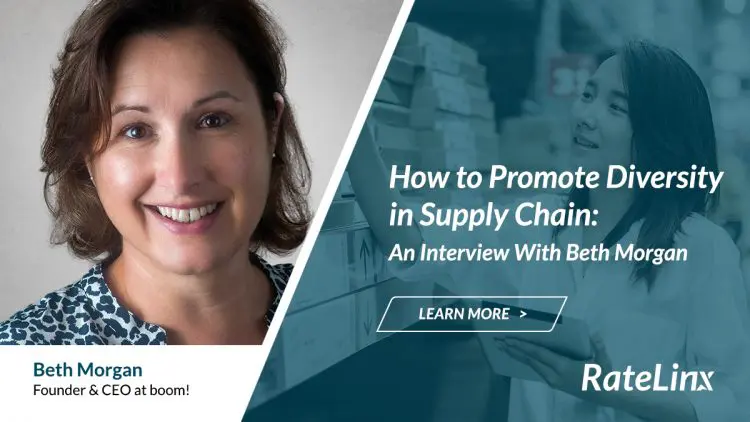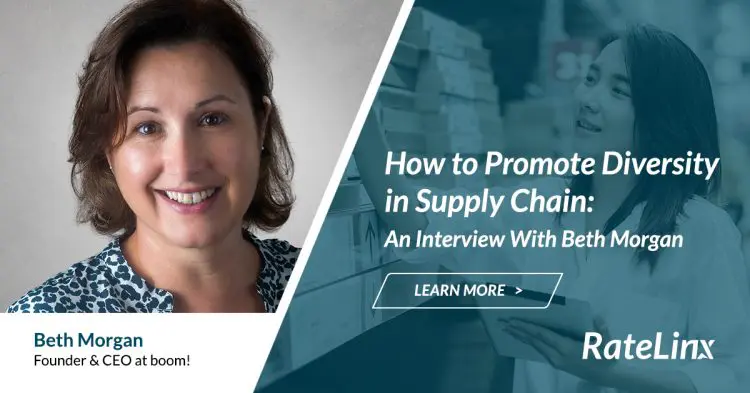Diversity and inclusion are vital to a healthy supply chain. Including women and minorities in leadership positions helps companies attract the best talent, spark creativity, build brand value, and boost financial performance.
Despite the advantages to supply chain diversity, the upper ranks of the supply chain remain predominantly male and white. In 2020, just 17% of chief supply chain officers are women. While this is nearly double the rate of 9% from five years ago, there’s still a long way to go.
Filling top supply chain roles with women and minorities isn’t about setting and meeting quotas. It’s about ensuring these individuals have the sponsorship and support to rise through the ranks.
“Above the surface of the water, there are some very practical, obvious things that companies can do to promote diversity,” she says. This starts with “having the conversation and then more strategically, and more importantly, setting intention, through goals and targets about what needs to be achieved, and then having a plan to back that up.”
For tips on promoting diversity in the supply chain, we spoke to Beth Morgan. Beth is the founder of boom!, a global online community that brings together aspiring and experienced female supply chain professionals. Their goal is to enable the advancement and acceleration of the role and careers of women in supply chain, for the benefit of all.
Read on for Beth’s insights on supply chain diversity, cultural and digital transformation, and advice for women who want to lead.
Featured Expert

Beth Morgan
One of the most prolific female voices among supply chain and logistics leaders, Beth is committed to the advancement and acceleration of the role and careers of women in supply chain. She’s also a foremost authority on supply chain research and analysis.
Recommended Reading:
For two decades, Beth worked as an industry analyst in the supply chain. One topic of particular interest was supply chain diversity on the talent side. In fact, she says advising companies about diversity inspired her to become “more hands-on … making a difference rather than just writing about it and talking about it.”
Boom! launched in September 2019. “It’s been a fantastic year, bringing together women from, I believe, 41 different countries … to share their experiences, to ask questions of each other, to support each other, to make connections, to build their networks, to inspire,” Beth says.
Disrupting the Supply Chain With a boom!
While there is a growing commitment to supply chain diversity, it remains difficult for many women to access resources for developing leadership skills and expanding their supply chain knowledge. How can leaders bridge the gaps?
According to Beth, one particular need is generating knowledge about the career path for women in supply chain. What skills and training do women need to rise to leadership levels? How can they excel in their current roles?
“That’s really what [boom!] is about: to help raise the profile for women in supply chain. And to help individuals who develop in their careers have balance with their personal lives.” Beth says.
Beth feels it is imperative to give younger, less experienced women exposure to more senior female leaders in supply chain. To that end, boom! conducts monthly interviews with supply chain leaders to share knowledge with the next generation.
Live, virtual round tables with women in leadership positions help expand the conversation, as well. “To have direct conversations, you can sit around the same virtual table in many cases,” she says. “And that’s quite a unique experience to have that level of access and exposure, and to learn from their experience.”
“We also look at what projects people are working on,” Beth notes.”So what’s happening in this company in terms of what they’re doing in sustainability? What are they doing over here in terms of logistics transformation?”
Like what you’re reading?
One thing that has quickly become clear: the women in the boom! community aren’t just looking for shortcuts to their next position; they also want to make the supply chain more accessible for everyone.
“Not only did women want to … support themselves individually, but they also wanted to learn what companies could do to help develop, nurture, and promote women into more senior leadership roles,” Beth explains.
To that end, the boom! community has also expanded to include men. “Because clearly, we’re all part of this conversation,” she says.
Unique Perspectives and Aha Moments
For Beth, heading up the boom! community has been a powerful experience. “I’ve learned so much on many levels,” she says. “Everybody has their unique perspective, their unique experience, their unique skill that they bring to the table. Of course, we all do as humans, but we’re looking at some of the issues here through a very common lens … as colleagues in the supply chain profession, also as women. There’s a lot of power in that.”
“Diversity is the stuff that can be done to bring everybody to the table. But the inclusion part is really: What is the actual experience for people once they’re within the organization? And that is often the hardest challenge to address, but it’s equally, if not more, important.”
Beth feels energized by the shared knowledge and the meaningful connections that occur within the network. “Having those conversations, bringing people together, and then people getting something out of that–For me, that’s what drives me to keep going. It’s those beautiful moments of connection. It is wonderful to have a community and find those organic moments that make it something bigger than itself.”
Striving for More Supply Chain Diversity
When asked about the obstacles in the way of more supply chain diversity, Beth notes, “We could probably spend several days talking about this.”
While it’s going to be different for different organizations, Beth says that the challenges fall into two basic categories. “Above the surface of the water, there are some very practical, obvious things that companies can do to promote diversity,” she says. This starts with “having the conversation and then more strategically, and more importantly, setting intention, through goals and targets about what needs to be achieved, and then having a plan to back that up.”
But what’s “under the water” also matters — namely, the culture of an organization, which is “a little less obvious, and probably often more challenging to address.” Addressing culture doesn’t mean just ticking off the box to diversity.
“It’s not just about diversity, it’s about the inclusion part as well,” Beth says. “Diversity is the stuff that can be done to bring everybody to the table. But the inclusion part is really: What is the actual experience for people once they’re within the organization? And that is often the hardest challenge to address, but it’s equally, if not more, important.”
Advice for Women in Supply Chain Who Want to Lead
To prepare for a leadership role, Beth says women in supply chain need to “Step up, step back, and see the bigger picture of how the supply chain fits together.”
For most women, this will require expanded knowledge about the supply chain beyond their core focus. “For anybody who’s looking longer term to develop into a more senior role, the opportunity to take on roles, rotations, or perhaps change roles into other parts of the supply chain, to act to gain the end-to-end experience is invaluable,” she says.
But beyond this practical advice, Beth has another recommendation for women that can be summed up in one word: confidence.
You may also be interested in…
“Men are more likely to go for a more senior role when they don’t have all the required skills in place. And a woman will hold back and say, ‘Well, I can’t do that job, because I don’t have enough experience here,'” Beth says. Research indicates that women only apply for a role when they meet 100% of the criteria; in contrast, men usually apply if they meet 60% of the requirements.
“But don’t wait until you have all the pieces in place before you consider taking on a more senior role,” Beth urges women. “Just go for it and have the confidence — particularly if somebody says, ‘You can do this.’”
Beth also recommends that women find strength in their networks. “Look for support: from books, from your network, from mentors, from your champions. Because it is a step up, it is a growth opportunity. So take advantage of the support mechanisms around you as you go through that experience.”
Gearing up for Supply Chain Transformation
Beth believes that we’re heading toward a major supply chain transformation — a change in leadership style from what she describes as “the old traditional command and control culture” to a more inclusive environment where managers facilitate career growth, creative-thinking, and accountability.
In other words, a supply chain where leaders “work with our teams to not just tell them what to do, but to bring everybody into the conversation.” Beth says. “It might sound like it’s a lot more work to do that, but actually, in the longer term, you’re doing less. You’re empowering people to take on that responsibility for leading themselves — not in everything, but in significant ways.”
“I think it’s hats off to everybody in supply chain who’s managed to cope with all the disruptions that we’ve had this year due to the pandemic”
And it’s not like this is an optional change — at least not for long. “We have young generations today expecting a different style of leadership,” Beth notes.
Harnessing Technology in Supply Chain Innovation
On the broader issue of supply chain transformation, Beth says the right leadership and culture are just as important as making the right tech investments.
“We have amazing technologies today to enable us to do quite fantastic things,” she says. “We’ve evolved those technological advances in a very short space of time. We need to make sure that we are enabling forums for collaboration and innovation, in ways that match the technological advancement.”
This means using technological advances to optimize the contributions of people — not replace them. Using technology to automate processes and streamline tasks, we can grant people more time and capacity to do higher-value activities, such as strategizing for the future. “We need to put those cultures in place — those management styles — to enable people to actually make the most of the technology,” Beth says.
Hallmarks of Supply Chain Excellence
The COVID-19 pandemic has disrupted the supply chain in — cliche as it may sound — unprecedented ways. “I think it’s hats off to everybody in supply chain who’s managed to cope with all the disruptions that we’ve had this year due to the pandemic,” Beth says.
“There are two areas where supply chain leadership has really excelled this year,” she says. “One is resilience and robustness. When you turn the tap on, water comes out … [There’s] food on the shelf, medicine in the hospitals — all those sorts of things that we often take for granted.”
The second area of excellence is innovation. These unusual times have allowed us “to actually do things so creatively in ways that perhaps we hadn’t even thought of before, or thought we couldn’t do before,” Beth says. “We’ve been pushed into those situations. And we’ve seen quite amazing things happen.”
Make Your Own Boom
A diverse supply chain is a strong supply chain. We know that inclusion makes companies more performant, innovative, and attractive to customers and employees. But there is still work to be done.
Networks like boom! are a vital part of the solution — and so are you. To learn more about promoting supply chain diversity or how to position yourself for a leadership position, follow Beth on LinkedIn or Twitter.









